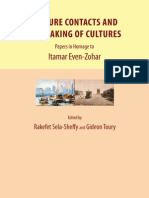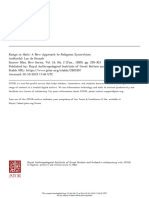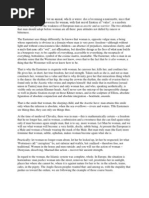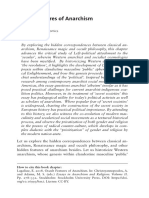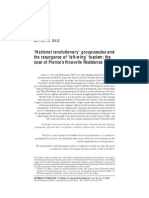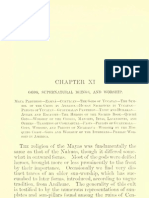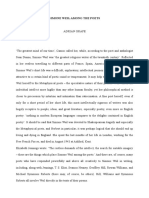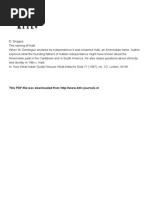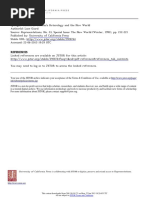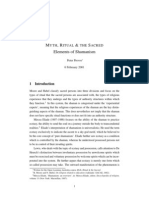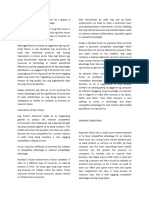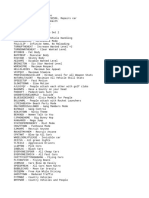Alfred Metraux
Alfred Metraux
Uploaded by
Makunaima KulaCopyright:
Available Formats
Alfred Metraux
Alfred Metraux
Uploaded by
Makunaima KulaOriginal Description:
Original Title
Copyright
Available Formats
Share this document
Did you find this document useful?
Is this content inappropriate?
Copyright:
Available Formats
Alfred Metraux
Alfred Metraux
Uploaded by
Makunaima KulaCopyright:
Available Formats
ALFRED METRAUX 1902-1963 ALFRED METRAUX died in Paris on April 12, 1963.
He was, in my opinion, the world's foremost authority on the South American Indian. His work and interests, however, ranged widely into other fields and other geographical areas. He was an influential teacher, a tireless field researcher, a productive writer, an efficient administrator, and an imaginative planner of projects in applied social science. Above all, he was a man of great erudition. He was truly a citizen of the world. Born in Lausanne, Switzerland, in 1902, he spent much of his childhood in Argentina where his father was a well known surgeon resident in Mendoza. He received his secondary and university education in Europe, at the Classical Gymnasium of Lausanne, the Ecole Nationale des Chartes in Paris, the Ecole Nationale des Langues Orientales (Diplome, 1925), the Ecole Pratique des Hautes ]tudes (Diplome, 1927) and the Sorbonne (Docteur es Lettres, 1928). He also studied in Sweden, in G6teborg's Hogskola, and did research at the Goteborg Museum. Among his teachers were Marcel Mauss, Paul Rivet, and Erland von Nordenskiold. While he was still a student he entered into correspondence with Father John Cooper who intro603
604
A merican A nthropologist
[66, 1964]
duced him to the American school of cultural anthropology. It is said that Father Cooper did not realize at first that his scholarly correspondent was only 19 or 20 years old. They actually met much later, when Metraux came to the United States; but Father Cooper seems to have had considerable influence on Alfred Metraux's thought. Metraux combined in his work the best of both the European and the American tradition of historical anthropology. His professional career was equally cosmopolitan. He founded and was the first director (1928-1934) of the Institute of Ethnology at the University of Tucuman (Argentina). In 1934-35, he led a French expedition to Easter Island, and in 1936-38, he was a Fellow of the Bishop Museum in Honolulu. In 1938-39, he was a Bishop Museum visiting professor at Yale University. In 1939, he returned to Argentina and Bolivia for field research on a Guggenheim Fellowship. In 1940, upon his return to the United States from South America, he was in residence at Yale University with a renewal of his Guggenheim Fellowship. That next year, he worked with the Cross Cultural Survey (now the Human Relations Area Files) on South American data and was associated with such people as John Dollard, Leonard Bloomfield, and others of the Institute of Human Relations. In 1941, he joined the staff of the Bureau of American Ethnology of the Smithsonian Institution. There, from 1941 to 1945, he played an important role in producing the monumental Handbook of South American Indians. Perhaps no other writer contributed as many pages to this work. As the editor, Julian Steward, acknowledges, "The extent of his (Metraux's) contribution is by no means indicated by the large number of articles appearing under his name. With an unsurpassed knowledge of South American ethnology and ever generous of his time, his advice and help to the editor and contributors alike have been a major factor in the successful completion of the work" (Vol. I, p. 9). In addition, Alfred Metraux taught briefly at the University of California, Berkeley (1938), the Escuela Nacional de Anthropologia, Mexico (1943), the Colegio de Mexico (1943), and the Faculdad Latino-Americana de Ciencias Sociales, Santiago, Chile (1959-60). At the time of his death, he was Professor of South American Anthropology at the Ecole Pratique des Hautes Etudes, Paris. In the early spring of 1945, Alfred Metraux went to Europe as a member of the United States Bombing Survey and he saw the physical and moral desolation of Europe. Although he had by then become a citizen of the United States, this experience seems to have reaffirmed, in a way, his traditional ties with Europe. It also strengthened his belief in the necessity for European unity and for the need of a firm basis for international, inter-cultural, and inter-racial understanding. His early view of war devastated Europe was important in his decision in 1946 to take a post on the secretariat of the United Nations. Thus, from 1946 until 1962, he worked for his ideals of international and inter-cultural understanding within the framework of international organization with only occasional excursions into academic life and into anthropological field research. In 1946 and 1947, he was a member of the Department of Social Affairs of
Obituaries
605
the United Nations, but in 1947 he was assigned to UNESCO, and finally, in 1950, he became a permanent member of UNESCO's Department of Social Science. As an international civil servant, he served the world and his profession well. He took part in the Hylean Amazon project in 1947-48; he led the UNESCO Marbial Valley (Haiti) anthropological survey from 1948 to 1950; with personnel from the international Labor Office, he studied the internal migrations of the Aymara and Quechua Indians in Peru and Bolivia (1954). He edited the series of pamphlets on The Race Question and Modern Thoughtand The Race Questionand Modern Science, published by UNESCO since 1950. He also organized the research that led to a series of volumes on race relations in Brazil, such as "As relaojes raciais entrenegrose brancosem Sdo Paulo," edited by Roger Bastide and Florestan Fernandes (Sao Paulo, 1955), Race and Class in Rural Brazil, edited by Charles Wagley (UNESCO, Paris, 1952), and others. At UNESCO, he was responsible for the participation of anthropologists in many important projects around the world, and he consistently emphasized the anthropological point of view in all of the many programs with which he was associated. Anthropology has lost not only a productive scholar, but an effective translator of anthropological theory and knowledge into action. I first met Alfred Metraux in 1939 when he was teaching at Yale University. I hoped after completing my doctoral dissertation to undertake field research in South America, perhaps in the Gran Chaco, perhaps in Brazil. My knowledge of South American ethnography was scanty, for South America was somewhat of an ethnographic "dark continent" at the time; the data were scarce and were published in Spanish, Portuguese, Italian, French, and German. I arrived in New Haven just before Metraux was to lecture. That day he discussed the work of the 18th century Jesuit, Sanchez Labrador (El Paraguay catolico) of whom I had never heard. Before the day was over, I had heard of, and was armed with a long bibliography on the Chaco and on Brazilian Indians. I also met through Metraux that day a graduate student at Yale, a man about my own age named Allan Holmberg, who, under Metraux's guidance was also determined to do field research in South America. At first, I was attracted by Metraux's invitation to join forces with him and to work in the Argentine Chaco; but then out of his notes, he recommended the Tapirape, a Tupi tribe of Central Brazil, which Baron von Nordenskiold suspected to be the remnants of the now extinct Tupinamba (which they turned out not to be). In any case, I sailed on the SS ARGENTINA in January 1939, in the company of Alfred Metraux-he, on his way to Argentina, and I to Brazil. The 12 days aboard ship before reaching Rio de Janeiro were instructive and delightful for a younger anthropologist. Metraux talked of South American anthropological problems; briefed me on conditions in the field and on people whom I would meet and upon whom I would depend. He gave me letters of introduction to several people. He was well known in Brazil for his scholarly studies of the Tupinamba, based on early sources. In his two days in Rio de Janeiro, he introduced me to colleagues at the Museu Nacional, which was to be my research base for many years to come. Thus began a rich professional association and
606
A merican A nthropologist
[66, 1964]
friendship which lasted from 1939 until his death. I use these personal reminiscences to illustrate something about the man. He was able, out of his own enthusiasm for his subject and his work, to impart enthusiasm to others. And his influence extended internationally. Florestan Fernandes, the well known Brazilian sociologist whose own brilliant studies of the Tupinamba derive from and develop Metraux's earlier works, glows when he tells of the dinner he cooked himself for "O Mestre Metraux." One constantly encounters anthropologists from Latin America and Europe whose careers have been influenced by Alfred Metraux-and yet he spent so little time in formal teaching. Alfred Metraux valued field ethnography more than theory. He let the facts speak for themselves, and many of his facts modified anthropological theory. Yet, one felt that he was too restless and too eager to be on his way to produce detailed and lengthy field reports such as those of Curt Nimuendajuion the Brazilian Ge. He was a sensitive field worker with many years of experience, and his articles on the Argentine Chaco and his book on Haitian Vodun indicate that he gathered careful and objective data in the field. He liked to think of himself as a field ethnologist. Any evening with him led to stories of nights around a fire with Argentine gauchos,his last stay with the semi-pacified Kayapo of Brazil, his period of residence on Easter Island, a Haitian vodun ceremony, or a candombleceremony in Bahia which he had attended with his friend Pierre Verger. The truth is, I suppose, that Alfred Metraux was also a romantic who valued the human experiences field research can bring to an anthropologist. | His great strength was, in my opinion, synthesis and historical research. His two books and many articles on the Tupinamba, based on reports by 16th and 17th century chroniclers, are classics. His studies of Argentine, Paraguayan and Bolivian tribes are often based more on historical sources than on field work; and he often was the only person to know the obscure data on an extinct tribe. In other words, he was fundamentally a scholar, but a scholar willing and able to undertake the tedious work of empirical historical and field research. A man of his erudition and knowledge of European languages (he wrote well in French, Spanish, and English) would be hard to find in anthropology today. As one might well imagine, with Metraux's talents and interests, he was often irked by some of his mundane obligations as a staff member of UNESCO. But, in fact, he performed them well and efficiently. He was an inveterate world traveller. He was always plotting how to relieve himself of administrative duties, but always accepted the obligations of new projects and programs. In recent years, he wrote his books and articles at night and on weekends. He had looked forward to teaching and "pure" research after his retirement from UNESCO in 1962 and two students from Paris were waiting for him in Paraguay to undertake field work among the Guayaki when he died. Alfred Metraux was married three times. Each of his wives was in a different way a scientific collaborator. His first wife, Eva Spiro Metraux, translated anthropological materials from English to French. His second wife, Rhoda Bubendey Metraux did research with him in Mexico, Argentina, and Haiti and
Obituaries
607
is today a well known anthropologist. More recently, he married Fernande Schulmann who accompanied him to Chile, Peru, and Brazil and who planned to work with him in Paraguay. He is survived also by his brother Guy Metraux of Paris, his sister Vera Conne of Lausanne, and by two sons:-Eric Metraux from his first marriage, and Daniel Alfred, the son of Rhoda Metraux. He is mourned by his family, and his many friends and colleagues on two continents.1 CHARLESWAGLEY Columbia University
BIBLIOGRAPHY OF ALFRED METRAUX2 1925 De la methode dans les recherches ethnographiques. Revue d'Ethnographie et des Traditions Populaires v. 6:262-287. Paris. Sur un mode americain du rite du balancement. Proceedings of the 21st International Congress of Americanists (G6teborg, 1924), pp. 596-606. G6teborg. 1927 Le baton de rythme. Contribution a l'etude de la distribution geographique des elements de culture d'origine melanesienne en Amerique du Sud. Journal de la Societe des Am6ricanistes de Paris (n.s.) 19:117-122. Les migrations historiques des Tupi-Guarani. Journal de la Societe des Americanistes de Paris (n.s.) 19:1-45. Nationalmuseets fjerprydelser fra Tupinamba' erne. Geografisk Tidsskrift 30:258-274. Copenhagen. Une ratete ethnographique du Musee de Bale, le manteau Tupinamba. Actes de la Societe Helvetique des Sciences Naturelles (2eme partie). Basel. 1928 Ce qui reste des grandes civilisations de l'Amerique. L'Art Precolombien, pp. 33-46. Paris. La civilisation materielle des tribus Tupi-Guarani. Paris, Librairie Orientaliste P. Geuthner. La religion des Tupinamba et ses rapports avec celle des autres tribus Tupi-Guarani. Bibliotheque de l'Ecole des Hautes Etudes, Sciences Religieuses, vol. 15. Paris, Librairie Ernest Leroux. Les arts anciens de l'Amerique. Exposition organisee au Musee des Arts Decoratifs, maijuin 1928, par A. Metraux et Georges-Henri Riviere. Paris, G. Van Oest. Les migrations historiques des tribus Tupi-Guarani. Journal de la Societe des Americanistes de Paris 20:390-392. Une decouverte biologique des Indiens de l'Amerique du Sud: la decoloration artificielle des plumes sur les oiseaux vicants. Journal de la Societe des Americanistes de Paris 20:181-192. 1929 Contribution a l'ethnographie et a l'archeologie de la Province de Mendoza (Rep. Argentine). Revista del Instituto de Etnologia de la Universidad Nacional de Tucuman, tomo 1, entrega 1, pp. 5-74. La alfareria de los indios Chiriguanos. Ensayos, afio 1, no. 2. Les indiens Waitaka (A propos d'un manuscript inedit du cosmographe Andre Thevet). Journal de la Societe des Americanistes de Paris 21:107-126. Un ancien document peu connu sur les Guarayu de la Bolivie orientale. "Missio in provinciam Santae Crucis in Annuae litterarae Societatis Jesu 1589." Anthropos 24:913-941. 1930 Etudes sur la civilisation des indiens Chiriguano. Revista del Instituto de Etnologia de la Universidad Nacional de Tucuman, tomo 1, entrega 3, pp. 295-494. La civilisation materielle et la vie sociale et religieuse des indiens Ze du Bresil meridional et oriental. Hermann Ploetz and A. Metraux. Revista del Instituto de Etnologia de la Universidad Nacional de Tucuman, tomo 1, entrega 1, pp. 107-238. La secularisation des missions franciscaines du Chaco bolivien. Anthropos 25:315-316. Les indiens Kamakan, Pataso et Kutago (D'apr[s le journal de route inedit del'explorateur frangais J. B. Douville). Revista del Instituto de Etnologia de la Universidad Nacional de Tucuman, tomo 1, entrega 1, pp. 239-293,
608
American Anthropologist
[66, 1964]
1931 Contribution a l'etudede l'archeologie du courssuperieur et moyende l'Amazone. Revista del Museode la Plata 33:119-184. BuenosAires. Les hommes-dieux et dansl'Amerique chezles Chiriguano du Sud.Revistadel Institutode Nacionalde Tucuman, tomo2, entrega1, pp. 61-92. Etnologiade la Universidad Observaciones sobrepsicologiade los indiosChiriguanos. Solar1:89-122. BuenosAires. Un mundoperdido: la tribude los Chipayasde Carangas. Sur 1:98-131.BuenosAires. 1932 A proposde deuxobjectsTupinamba du Museed'Ethnographie du Trocadero. Bulletindu Museed'Ethnographie du Trocadero 3:3-18. Paris. En folkspillrafran en f6rgangenandinskkultur. Ymer 52:233-271. Chipayaindianerna. Stockholm. Le musee ethnographique de G6teborget l'oeuvred'ErlandNordenski6ld Introduction. [by Henry Wassen].Revista del Instituto de Etnologiade la UniversidadNacional de Tucuman,tomo 2, entrega2, pp. 233-237. Le traitementmagiquedes maladies chez les indiens Uro-Chipaya de la Province de de PatologiaRegionaldel Norte y Filiales7:816(Bolivie).Sociedad Carangas Argentina 822. Tucuman. Mitos y cuentosde los indios Chiriguano. Revista del Museode la Plata 33:119-184. La Plata. 1933 La obra de las misionesinglesasen el Chaco.Journalde la Societedes Americanistes de Paris25:205-209. Nouvelles de la Mission A. Metraux.Journalde la Societe des Americanistes de Paris 25:203-205. Un chapitreinedit du cosmographe Andr6Thevet sur la geographie et l'ethnographie du Bresil.Journalde la Societedes Am6ricanistes de Paris25:31-40. 1934 Contribution au folk-lore andin.Journal de la Societedes Americanistes de Paris26:67-102. El estado actual de nuestrosconocimientos sobrela extensi6nprimitive de la influencia Guaraniy Arawaken el continentesudamericano. of the 25th International Proceedings of Americanists (La Plata, 1932),vol. 1, pp. 181-190.BuenosAires. Congress socialeet les survivancesreligieusesdes indiens Uru-Cipaya de Carangas L'organisation of the 25th International of Americanists (Bolivie).Proceedings (La Plata, 1932), Congress vol. 1, pp. 191-213.BuenosAires. 1935 Civilizaci6n materialde los indios Uro-Chipaya de Carangas(Bolivia).Revista del Instituto de Etnologiade la Universidad Nacionalde Tucuman,tomo 3, entrega1, pp. 85-130. El museoetnografico de Gotemburgo. Revista Geografica Americana 3:253-256. Buenos Aires. El universoy la naturaleza a trav6sde las representaciones miticasde dos tribussalvajesde la Argentina. Sur5:54-70. BuenosAires. El universoy la naturalezaen las representaciones miticas de dos tribus salvajes de la Nacionalde RepublicaArgentina.Revista del Instituto de Etnologiade la Universidad Tucuman,tomo 3, entrega1, pp. 131-144. La mujeren la vida social y religiosade los indios Chiriguano. Revista del Instituto de Nacionalde Tucuman,tomo3, entrega3, pp. 145-166. Etnologiade la Universidad La religi6nsecretay la mitologiade los indiosUro-Chipaya de Carangas (Bolivia).Revista del Instituto de Etnologiade la Universidad Nacionalde Tucuman,tomo3, entrega1, pp. 7-84. La survivancedu vetementincasiquechez les indiensChipayade Carangas. Bulletindu Museed'Ethnographie du Trocadero 8:15-24. Paris. du Sud. Bulletinde la Societedes Americanistes de jeux de ficellede l'Am6rique Quelques Belgique17:67-81. Brussels. Voyageautourde l'Ile de Paques.Revuede Paris42:372-399. 1935- Les indiens Uro-Cipayade Carangas.Journalde la Societe des Americanistes de Paris 1936 27:111-128, 325-415; 28:155-207, 337-394. 1936 [Articles et Librairie frangaise. Frangaise in] Encyclopedie Paris, Comitede l'Encyclopedie Larousse.
Obituaries
609
1937
1938
1939 1940
1941
1941 1942
1943
1943 1944
L'Amerique du Sud, vol. 7, fasc. 40, pp. 1-17. Oceanie et Australie, vol. 7, fasc. 32, pp. 1-18. La structure sociale, vol. 7, fasc. 14, pp. 1-16. Contribution a l'ethnographie et a la linguistique des indiens Uro d'Ancoaqui (Bolivie). Journal de la Societe des Americanistes de Paris 28:75-110. Los indios Uro Chipayas de Carangas. Revista Geografica Americana 6:98-106. Buenos Aires. Archeologie de la Province d'Oruro, Bolivie (mounds de Belen). Journal de la Societe des Americanistes de Paris 29:147-155. Etudes d'ethnographie Toba-Pilaga (Gran Chaco). Anthropos 32:171-194, 378-401. Histoire du monde et de l'homme. Textes indiens presentes par A. Metraux. La Nouvelle Revue Francaise, 24eme annee, no. 276, pp. 7-27. The kings of Easter Island. Journal of the Polynesian Society 16:41-62. New Plymouth, N.Z. Une feodalite cannibale en Polyn6sie francaise (Les iles Gambler [Mangareva] et ]'oeuvre du P. H. Laval). Revue de Paris 44:637-661. [Editor and annotator, with Fr. Maurice Desmedt] Mangareva, l'histoire ancienne d'un peuple polynesien, par le P. Honore Laval. Memoires ethnographiques conserves aux archives de la congregation du Sacre-Coeur de Piopus. Paris, Librairie Orientaliste P. Geuthner. The proto-Indian script and the Easter Island tablets (a critical study). Anthropos 33:218239. Myths and tales of the Matako Indians (The Gran Chaco, Argentina). Etnologiska Studien 9:1-127. Goteborg. Ethnology of Easter Island. Bernice P. Bishop Museum, Bulletin no. 160. Honolulu. Los indios Chapakura del Oriente Boliviano. Anales del Instituto de Etnografia Americana 1:117-127. Mendoza. Los indios Manao. Anales del Instituto de Etnografia Americana 1:235-244. Mendoza. Paganism and christianity among the Bolivian Indians. Inter-American Quarterly 2:53-60. Algunos mitos y cuentos de los Pilaga. Anales del Instituto de Etnografia Americana 2:169-188. Mendoza. L'Ile de Paques. Paris, Editions de la Nouvelle Revue Frangaise. Messiahs of South America. Inter-American Quarterly 3:53-60. [Translation from the English] La religion primitive, sa nature et son origine, by Paul Radin. Paris, Gallimard. Le shamanisme araucan. Revista del Instituto de Etnologia de la Universidad Nacional de Tucum,n, tomo 2, entrega 2, pp. 309-362. The linguistic affinities of the Enimaga (Cochaboth) group. American Anthropologist 44:720-721. Medicine men of the Chaco. Natural History 50:6-13. New York. The native tribes of eastern Bolivia and western Matto Grosso. Bureau of American Ethnology, Bulletin no. 134, Smithsonian Institution, Washington, D. C. A Quechua messiah in eastern Peru. American Anthropologist 44:721-725. Le caractere de la conquete jesuistique. Acta Americana 1:69-82. Mexico City and Los Angeles. A myth of the Chamacoco Indians and its social significance. Journal of American Folklore 46:113-119. The social organization and religion of the Mojo and Manasi. Primitive Man 16:1-30. Washington, D. C. Suicide among the Matako of the Argentine Gran Chaco. America Indigena 3:198-209. Mexico City. The contribution of the Jesuits to the exploration and anthropology of South America. Mid-America 26:183-191. Chicago.
610
American Anthropologist
[66, 1964]
Estudiosde etnografiachaquense.Analesdel Instituto de EtnografiaAmericana 5:263314. Mendoza. La causay el tratamiento entrelos indiosde la regi6ntropical magicode las enfermedades AmericaIndigena4:157-164. MexicoCity. sudamericana. du Sudtropicale. ActaAmericana Le shamanisme chezles indiensde l'Amerique 2:197-219. MexicoCity andLosAngeles. Nota etnograficasobre los indios Mataco del Gran Chaco argentino.Relacionesde la de Antropologia Sociedad 4:7-18. BuenosAires. Argentina SouthAmerican of American Folklore Thunderbirds. 57:132-135. Journal Indians.Journalof the Washington a biologicaldiscoveryof SouthAmerican "Tapirage," Academyof Sciences34:252-254. 1945 EasterIsland.Smithsonian Institution,AnnualReportfor 1944,pp. 435-452.WasIington, D. C. 1945 Le shamanisme 7:157-168.SaoPaulo. chezles indiensdu GranChaco.Sociologia Peopleof the past. NaturalHistory54:425-431.New York. 1945- Ritos de transitode los indiossudamericanos. Americana Analesdel Institutode Etnografia 1946 6:117-128; 7:149-160. Mendoza. 2:84-92. 1946 The conceptof soul in Haitianvodu. Southwestern Journalof Anthropology [Contributions in] Handbookof South AmericanIndians,edited by Julian H. Steward. Bureauof American Institution,WashingEthnology,Bulletinno. 143,vol. 1. Smithsonian ton, D. C. The Botocudo,pp. 531-540. The Caingang, pp. 445-475. The Camacan linguisticfamily (AlfredMetrauxand CurtNimeundaju), pp. 547-552. of the Chaco,pp. 197-370. Ethnography The Fulnio,p. 571. The Guaitaca,pp. 521-522. The Guat6,pp. 409-418. The Guayaki(AlfredMetrauxand HerbertBaldus),pp. 435-444. The Mashacali, Patash6, and Malali linguistic families (Alfred Metraux and Curt Nimuendaju),pp. 541-545. The Puri-Coroado linguisticfamily,pp. 523-530. The Teremembe, pp. 573-574. 1946 El Dios Supremo, en la mitologia America los Creadores sudamericana. y Heroesculturales Indigena6:9-25. MexicoCity. La civilisationguyano-amazonienne et ses provincesculturelles.Acta Americana 4:130153.MexicoCity andLos Angeles. of the American FolkMyths of the Tobaand PilagaIndiansof the GranChaco.Memoirs loreSociety,vol. 40. Philadelphia. SouthAmerican Indianliterature. editedby J. T. Shipley,vol. of Literature, Encyclopedia 2, pp. 851-863. Twinheroesin SouthAmerican of American Folklore 59:114-123. mythology.Journal 1947 Mourning ritesand burialformsof the SouthAmerican Indians.America Indigena7:7-44. MexicoCity. Note sur les indiensde la GuyaneFrancaise. de Journalde la Societedes Americanistes Paris36:232-235. Socialorganization of the Kaingang and Aweikoma. American 49:148-151. Anthropologist Somestatisticaldata about the GuyanoIndians.Acta Americana 5:242-243. MexicoCity and Los Angeles. 1948 [Contributions in] Handbookof South AmericanIndians, edited by Julian H. Steward. Bureauof AmericanEthnology,Bulletin no. 143, Smithsonian Institution, Washington, D. C. The Amanayi(CurtNimuendajui and AlfredMetraux),3:199-202. The Goajiro(JohnM. Armstrong and AlfredMetraux),4:369-383.
Obituaries
611
1949
19491951 1950
1950
1951
The Guarani, 3:69-94. The hunting and gathering tribes of the Rio Negro Basin, 3:861-867. The northeastern extension of Andean culture (Alfred Metraux and Paul Kirchhoff), 4:349-368. The Peban tribes (Julian H. Steward and Alfred Metraux), 3:728-736. Tribes of eastern Bolivia and the Madeira Headwaters, 3:381-454. Tribes of the eastern slopes of the Bolivian Andes 3:465-506. Tribes of the Jurua-Purus Basins, 3:657-686. Tribes of the middle and upper Amazon River, 3:687-712. The Tupinamba, 3:95-133. Ensayos de mitologia comparada sudamericana. America Indigena 8:9-30. Mexico City. Etude sur l'agriculture paysanne dans une vallee haitienne. Acta Americana, vol. 6, no. 3-4. Mexico City and Los Angeles. Status of folklore research in South America. Southwestern Journal of Anthropology 4:148154. Anthropology and the Unesco pilot project of Marbial (Haiti). America Indigena, vol. 3, no. 3. Mexico City. [Contributions in] Handbook of South American Indians, edited by Julian H. Steward. Bureau of American Ethnology, Bulletin no. 143, vol. 5, Smithsonian Institution, Washington, D. C. Bark cloth, pp. 67-68. Boys' initiation rites, pp. 375-382. The couvade, pp. 369-374. Jesuit missions in South America, pp. 645-653. Religion and shamanism, pp. 559-599. Rubber, pp. 227-228. Warfare, cannibalism, and human trophies, pp. 383-409. Weapons, pp. 229-263. Les enquetes ethnographiques dans le bassin de l'Amazone en 1948. Journal de la Societe des Americanistes de Paris, 38:177-181. L'habitation paysanne en Haiti. Bulletin de la Societe Neuch&teloise de Geographie, vol. 55, fasc. 1. Neuchatel. A religiao dos Tupinambas e suas relag6es com a das demais tribus tupi-guaranis. Translation by Estevao Pinto of La religion des Tupinamba et ses rapports avec celle des autres tribus Tupi-Guarani (1928). Sao Paulo, Companhia Editora Nacional (Cole;ao Brasiliana, vol. 267). Chants vodou. Les Temps Modernes, no. 52, pp. 1386-1393. Paris. The contribution of the Rev. Father Cooper to South American Ethnography. Primitive Man 23:39-48. Washington, D. C. La isla de Pascua. Translation by J. J. Arreola of L'Ile de Paques (1941). Mexico City, Fondo de Cultura Econ6mica. Les Peaux-Rouges de l'Amerique du Sud. Paris, Editions Bourrelier. L'Unesco et l'anthropologie. Le Monde Non-Chretien, octobre-decembre. Paris. Droit et coutume en matiere successorale dans la paysannerie haitienne. Zaire, avril. Louvain. Le voyage du Kon-Tiki et l'origine des Polynesiens. Revue de Paris 58:119-129. Les consequences de la decouverte de l'Amerique par Christophe Colomb. Les Conferences du Palais de la Decouverte (Universite de Paris). Les paysans haitiens. Presence Africaine, Cahiers Speciaux, no. 12 (Haiti, poetes noirs), pp. 112-135. L'Ile de Paques. Revised edition. Paris, Gallimard. Making a living in the Marbial valley (Haiti). L'homme et la terre dans la vallee de Marbial (Haiti). Report prepared by Alfred Metraux in collaboration with E. Berrouet and Dr. and Mrs. Jean Comhaire-Sylvain. Paris, UNESCO, Occasional Papers in Education, no. 10.
612
American Anthropologist
[66, 1964]
1952
1953
1954
1955
19551956 1956
1957
1958
Une nouvelle langue tapuya de la region de Bahia (Bresil). Journal de la Societe des Americanistes de Paris 40:51-58. Jesuites et indiens en Amerique du Sud. Revue de Paris 59:102-113. Le magicien chez les indiens des Guyanes et du Bresil. Cahiers du Sud, no. 36, pp. 380-396. Les indiens araucans de l'Argentine. Journal de la Societe des Americanistes de Paris 41:502-503. Applied anthropology in government: United Nations. In Anthropology today, edited by Sol Tax. Chicago, Chicago University Press. Croyances et pratiques magiques dans la vallee du Marbial (Haiti). Journal de la Societe des Americanistes de Paris 42:135-198. Haitian creole: grammar-texts-vocabulary. Robert A. Hall, Jr., with the collaboration of Suzanne Comhaire-Sylvain, H. Ormonde McConnell, and Alfred Metraux. American Anthropologist, vol. 55, Memoir no. 74. La religion vodou en Haiti. Panorama du Monde et des Sciences, ete. Paris. Le culte vodou en Haiti. Revue de Paris 60:119-129. Les croyances animistes dans le vodou haitien. Memoires de l'Institut Frangais d'Afrique Noire, no. 27, pp. 239-244. Ifan-Dakar. Medecine et vodou en Haiti. Acta Tropica 10:28-68. Basel. Reactions psychologiques a la christianisation de la vallee de Marbial (Haiti). Revue de Psychologie des Peuples, 8eme annee, no. 3, pp. 250-267. Le Havre. Vodou et protestantisme. Revue de l'Histoire des Religions 144:198-216. Paris. Divinites et cultes vodous dans la vallee de Marbial (Haiti). Zaire, no. 7, pp. 675-707. Paris. "Land hunger" on the top of the Andes. Unesco Courier 7:4-9. Le Noel vodou en Haiti. Bulletin de la Societe Neuchateloise de Geographie, vol. 51, fasc. 5. Neuchatel. Les rites d'initiation dans le vodou haitien. Tribus (neue Folge), Band 5/5, pp. 177-198. Linden Museum, Stuttgart. Notes d'ethnographie Aymara. Journal de la Societe des Americanistes de Paris 43:225228. Rites funeraires des paysans haitiens. Arts et Traditions Populaires, no. 4, pp. 289-306. Datos sobre la tribu de los Chipayas. Alfred Metraux and others. Khana 3:74-80. Tupinamba war and cannibalism. In Readings in anthropology, edited by E. A. Hoebel. New York, McGraw-Hill. Les dieux et les esprits dans le vodou haitien. Societe Suisse des Americanistes, Bulletin no. 10, pp. 2-16; no, 11, pp. 1-9. Las migraciones internas de los indios Aymara en el Peru contemporaneo. Estudios antropol6gicos publicados en homenaje al doctor Manuel Gamio Mexico City, Sociedad Mexicana de Antropologia. Le mariage mystique dans le vodou. Cahiers du Sud 43:410-419. Marseille. Easter Island. Translation by Michael Bullock of L'Ile de Paques (1941, revised edition 1951). New York, Oxford University Press; London, A. Deutsch. Haiti, la terre, les hommes et les dieux. Neuchatel, Editions La Baconniere. Histoire du Vodou depuis la guerre d'independance jusqu'a nos jours. Presence Africaine, no. 16, pp. 135-150. Le vodou et le christianisme. Les Temps Modernes, 12ieme annee, no. 136, pp. 1848-1883. Paris. Les messies de l'Amerique du Sud. Archives de Sociologie des Religions 2:108-112. Paris. Les rites de naisssance dans le vodou haitien. Melanges Pittard (Brive, 1957), pp. 229-233. La naissance et la premiere enfance chez les indiens Cayapo du Xingu. Alfred Metraux and S. Dreyfus-Roche. Miscellanea Paul Rivet (Mexico City, 1958). Le vaudou haitien. Paris, Gallimard. O indio Guarani. Revista do Museu Julio de Castilhos e Arquivo Hist6rico do Rio Grande do Sul, vol. 7, pp. 35-78. P6rto Alegre.
Obituaries
613
1959 The ancientcivilizations of the Amazon:the presentstatus of the questionof theirorigins. Diogenes,no. 28, pp. 91-106. Chicago. of the Mataco Indians.HRAF source,file S17, vol. 4. New Report on the ethnography Haven. The revolution of the ax. Diogenes,no. 25, pp. 28-40. Chicago. of Le vaudouhaitien (1958). New York, Voodooin Haiti. Translation by Hugo Charteris Oxford UniversityPress. 1960 Haiti: black peasantsand voodoo. Translationby Peter Lengyel of Haiti: la terre, les hommeset les dieux (1957).New York,UniverseBooks. Revista do Museu Mythes et contes des indiens Cayapo (GroupeKuben-Kran-Kegn). Paulista12:7-35. Sao Paulo. 1961 The Incaempire: or socialism. Diogenes,no. 35, pp. 78-98. Chicago. despotism 1962 Disparitiondes indiensdans le Br6silcentral.Proceedings of the 34th International Con(Vienna,1960),pp. 104-109.Vienna. gressof Americanists Incasof today.UnescoCourier 15:15-21. Les Incas. Paris,Editionsdu Seuil. 1963 Does Life End at Sixty?UNESCOCourier, April:20-23 of South American Les Cahiers SomeFrenchprecursors [To be published] anthropology. d'HistoireMondiale.
NOTES 1I wish to thank Drs. Rhoda M6trauxand MargaretMead for providingme with Alfred M6traux's andforhelpin ascertaining basicbibliography manyfactsabouthis life. 2 Since AlfredMetrauxwrote in three languages in variousparts of the world,some of his articlesareobviouslymissingfromthis bibliography.
You might also like
- Tantra Song All That Is Shared Between UsDocument1 pageTantra Song All That Is Shared Between UsWangshosanNo ratings yet
- Even-Zohar Homage BookDocument494 pagesEven-Zohar Homage BookFatma Gül Özhan100% (1)
- Workforce Analyst GuideDocument53 pagesWorkforce Analyst GuideGrecia100% (2)
- AsmahanDocument4 pagesAsmahanJimmyNo ratings yet
- AyitiDocument5 pagesAyitiAlex Moore-MinottNo ratings yet
- The Moon Bear As A Symbol of YamaDocument24 pagesThe Moon Bear As A Symbol of YamaardeegeeNo ratings yet
- Royal Anthropological Institute of Great Britain and Ireland ManDocument15 pagesRoyal Anthropological Institute of Great Britain and Ireland ManAlex100% (1)
- Benjamin Hebblethwaite - Historical Linguistic Approaches To Haitian Creole Vodou Rites, Spirit Names and Songs - The Founders' Contribuitions To Asogwe VodouDocument18 pagesBenjamin Hebblethwaite - Historical Linguistic Approaches To Haitian Creole Vodou Rites, Spirit Names and Songs - The Founders' Contribuitions To Asogwe VodouErick Johnson CandeiasNo ratings yet
- El Prezente: Journal For Sephardic Studies Jurnal de Estudios SefaradisDocument69 pagesEl Prezente: Journal For Sephardic Studies Jurnal de Estudios SefaradisEliezer PapoNo ratings yet
- The Negative Jew and IndividualityDocument29 pagesThe Negative Jew and Individualityhihi nassarNo ratings yet
- Guido Di Giorgio - Short Note On Woman in East and WestDocument2 pagesGuido Di Giorgio - Short Note On Woman in East and WestBorisav92No ratings yet
- From Chicago To New Orleans An Back in The Internet Voudu New Orleans LouisianaDocument4 pagesFrom Chicago To New Orleans An Back in The Internet Voudu New Orleans LouisianaAnita100% (1)
- Essays in Anarchism and Religion.Document55 pagesEssays in Anarchism and Religion.canNo ratings yet
- BaleDocument26 pagesBaleMattNo ratings yet
- On The Importance of Visions Among The ShuarDocument42 pagesOn The Importance of Visions Among The ShuarYakir SagalNo ratings yet
- Multivalent Symbols of An Enclosing HandDocument32 pagesMultivalent Symbols of An Enclosing HandSofia CampioloNo ratings yet
- Novel Hallucinogens From Eastern Ecuador - David, Yost - 1983Document11 pagesNovel Hallucinogens From Eastern Ecuador - David, Yost - 1983Doug Ohnemus100% (1)
- Water Lily and Cosmic Serpent: Equivalent Conduits of The Maya Spirit RealmDocument35 pagesWater Lily and Cosmic Serpent: Equivalent Conduits of The Maya Spirit RealmmilosmouNo ratings yet
- 1805 Haitian Constitution-1Document8 pages1805 Haitian Constitution-1werd59100% (1)
- The Chronological Outline of The ScythiaDocument39 pagesThe Chronological Outline of The ScythiaPaul BiringNo ratings yet
- Orphism: The Oxford Classical Dictionary (3 Ed.)Document2 pagesOrphism: The Oxford Classical Dictionary (3 Ed.)brizendineNo ratings yet
- Schimmel Deciphering SignsDocument287 pagesSchimmel Deciphering SignsHusni ZulkarnainNo ratings yet
- Witkower Eagle and SerpentDocument40 pagesWitkower Eagle and SerpentJames L. Kelley100% (1)
- Flower Worlds and The Old Uto-AztecansDocument29 pagesFlower Worlds and The Old Uto-AztecansAnthony Pearson100% (1)
- Dionysiaca 01 NonnuoftDocument606 pagesDionysiaca 01 Nonnuoftbirsen0% (1)
- Esoteric Traditions of The Old Inca Empire - Peter Liefhebber PDFDocument4 pagesEsoteric Traditions of The Old Inca Empire - Peter Liefhebber PDFAlkimistNo ratings yet
- Michael Bertiaux The Voudon Gnostic WorkbookDocument3 pagesMichael Bertiaux The Voudon Gnostic WorkbookdsaNo ratings yet
- Dugin On ScholemDocument1 pageDugin On ScholemRebel D.No ratings yet
- Lugones Heterosexualism and The Colonial Modern Gender SystemDocument25 pagesLugones Heterosexualism and The Colonial Modern Gender SystemPrismNo ratings yet
- The Lost Kingdom of PaititiDocument1 pageThe Lost Kingdom of PaititiJose MtNo ratings yet
- Crooke, W - Popular Religion and Folklore of Northern India Vol 2 PDFDocument396 pagesCrooke, W - Popular Religion and Folklore of Northern India Vol 2 PDFAdina Olaru100% (2)
- Jurman The Osiris ChapelsDocument44 pagesJurman The Osiris ChapelsPaula Veiga100% (1)
- Jesuit MissionsDocument24 pagesJesuit MissionsMarzena KożyczkowskaNo ratings yet
- Wendish in Old Norse and NanlDocument33 pagesWendish in Old Norse and NanlДеан ГњидићNo ratings yet
- A Greek Cave Sanctuary in Sphakia SW CreteDocument54 pagesA Greek Cave Sanctuary in Sphakia SW CreteJeronimo BareaNo ratings yet
- This Content Downloaded From 176.63.26.172 On Wed, 14 Oct 2020 12:29:01 UTCDocument18 pagesThis Content Downloaded From 176.63.26.172 On Wed, 14 Oct 2020 12:29:01 UTCDomonkos Horváth100% (1)
- Supernatural AND: WorshipDocument49 pagesSupernatural AND: WorshipRussell HartillNo ratings yet
- Shaman Isms Today - AtkinsonDocument26 pagesShaman Isms Today - AtkinsonGabriel Lisboa100% (1)
- Jenkins, Richard - Disenchantment, Enchantment and Re-Enchantment. Max Weber at The MillenniumDocument22 pagesJenkins, Richard - Disenchantment, Enchantment and Re-Enchantment. Max Weber at The Millenniumdusanxx0% (1)
- The Libertine Gnostic Sect of The Phi Bio Nites According To EpiphaniusDocument18 pagesThe Libertine Gnostic Sect of The Phi Bio Nites According To Epiphaniussinisa937056No ratings yet
- Simone Weil Among The Poet1Document11 pagesSimone Weil Among The Poet1Roxana TrandafirNo ratings yet
- From Sacred Geography To Geopolitics - Aleksandr DuginDocument23 pagesFrom Sacred Geography To Geopolitics - Aleksandr DuginAnonymous eDvzmv100% (1)
- Tânia Stolze Lima - Juruna ShamanismDocument10 pagesTânia Stolze Lima - Juruna ShamanismtheherbsmithNo ratings yet
- Language, Culture, ResistanceDocument32 pagesLanguage, Culture, ResistanceRicardo Hernandez Lopez100% (1)
- Lenglensou Is A Fierce LoaDocument2 pagesLenglensou Is A Fierce LoacymcynNo ratings yet
- MendesDocument4 pagesMendesgenius147852No ratings yet
- Gede San Limit: Transcribed and Translated by Benjamin Hebblethwaite, Myrlande Denis and Tahiri Jean-BaptisteDocument5 pagesGede San Limit: Transcribed and Translated by Benjamin Hebblethwaite, Myrlande Denis and Tahiri Jean-Baptistengolo1No ratings yet
- Tap-Tap, Fula-Fula, Kia-Kia: The Haitian Bus in Atlantic PerspectiveDocument13 pagesTap-Tap, Fula-Fula, Kia-Kia: The Haitian Bus in Atlantic Perspectivejysouza11No ratings yet
- Met KalfuDocument1 pageMet KalfuBoriqua JenkinsNo ratings yet
- Fenichel, The Symbolic Equation Girl PhallusDocument13 pagesFenichel, The Symbolic Equation Girl PhallusSteven MillerNo ratings yet
- Moreau de ST Remy - Naming After The Haitian IndependanceDocument27 pagesMoreau de ST Remy - Naming After The Haitian IndependanceEddy Lagroue100% (1)
- Sex Symbolism in ReligionDocument159 pagesSex Symbolism in ReligionJeff WiitalaNo ratings yet
- Mambo Sallie Anne Glassman Is The Proprietor of The Island of Salvation BotanicaDocument3 pagesMambo Sallie Anne Glassman Is The Proprietor of The Island of Salvation Botanicashenlong8272No ratings yet
- Volume 26 Legon Journal of The Humanities PDFDocument174 pagesVolume 26 Legon Journal of The Humanities PDFRobin100% (1)
- Michel de Certeau's HeterologyDocument11 pagesMichel de Certeau's HeterologyWelton Nascimento100% (1)
- M, R & S Elements of Shamanism: YTH Itual THE AcredDocument4 pagesM, R & S Elements of Shamanism: YTH Itual THE AcredSeth Brogdon100% (1)
- The Akan Website ArticlesDocument3 pagesThe Akan Website ArticlesJ. LeonNo ratings yet
- BULAMAH, Rodrigo C. - Alfred Métraux. Between Ethnography and Applied KnowledgeDocument30 pagesBULAMAH, Rodrigo C. - Alfred Métraux. Between Ethnography and Applied KnowledgeAnonymous OeCloZYzNo ratings yet
- No Sun Helmets!' Melville & Frances Herskovits in Brazil: Livio SansoneDocument30 pagesNo Sun Helmets!' Melville & Frances Herskovits in Brazil: Livio SansoneLivio SansoneNo ratings yet
- Franz Boas: Ruth Benedict, Née Ruth Fulton, (Born June 5, 1887, New York, N.Y., U.SDocument6 pagesFranz Boas: Ruth Benedict, Née Ruth Fulton, (Born June 5, 1887, New York, N.Y., U.SjhanelleNo ratings yet
- Lewis - in Defense of Anthropology - 2014 PDFDocument18 pagesLewis - in Defense of Anthropology - 2014 PDFJorge Iván VergaraNo ratings yet
- About Sanskrit PDFDocument59 pagesAbout Sanskrit PDFSovan Chakraborty100% (3)
- Skin Grafting Dermatomes and Meshers BrochureDocument6 pagesSkin Grafting Dermatomes and Meshers BrochureJavier HuarcaNo ratings yet
- Multiple IntelligenceDocument6 pagesMultiple Intelligenceblessy80No ratings yet
- Rescue EMT Roll No SlipDocument1 pageRescue EMT Roll No SlipAnsar AliNo ratings yet
- Appointment Letter - Ashish LodhiDocument7 pagesAppointment Letter - Ashish LodhiPadmalavMahatoNo ratings yet
- Reviewer SemioticsDocument6 pagesReviewer SemioticsMelaiza Magno BatacanNo ratings yet
- IBTDocument3 pagesIBTjoy mesanaNo ratings yet
- SSLC 2022 SS Answer Key FinalDocument7 pagesSSLC 2022 SS Answer Key FinalKindiNo ratings yet
- (Foundations of Human Interaction) Radu Umbreș - Living With Distrust - Morality and Cooperation in A Romanian Village (2022, Oxford University Press) - Libgen - LiDocument247 pages(Foundations of Human Interaction) Radu Umbreș - Living With Distrust - Morality and Cooperation in A Romanian Village (2022, Oxford University Press) - Libgen - LiDigital Jah DubfreeromaniaNo ratings yet
- Cisco Networking Academy's Introduction To VLANs - ObjectivesDocument38 pagesCisco Networking Academy's Introduction To VLANs - ObjectivesStillward Laud Mark-MillsNo ratings yet
- Zeroth Review PPT TemplateDocument18 pagesZeroth Review PPT TemplatepriyanshudashofficialNo ratings yet
- Simple, Future, Future Continuous, Dan Future Perfect.Document1 pageSimple, Future, Future Continuous, Dan Future Perfect.Kang IuNo ratings yet
- Bits Zc471 CM Zc471 HHSM Zc471-l1Document30 pagesBits Zc471 CM Zc471 HHSM Zc471-l1mohimran2002No ratings yet
- Champions Ingles BookletDocument5 pagesChampions Ingles BookletLourdes SandovalNo ratings yet
- ClimatologyDocument26 pagesClimatologydjoatessNo ratings yet
- The Nervous System - BrainDocument25 pagesThe Nervous System - BrainRukhsarNo ratings yet
- NosferatuDocument117 pagesNosferatuOrhun BaşerNo ratings yet
- Budget Trust FormDocument6 pagesBudget Trust FormihasagayusernameNo ratings yet
- Narrative Report MILDocument6 pagesNarrative Report MILRhenz MahilumNo ratings yet
- Gta SA CheatsDocument2 pagesGta SA Cheatspraveenkumar11yogiNo ratings yet
- Honors Paper 2Document5 pagesHonors Paper 2api-300859090No ratings yet
- PWDDocument1 pagePWDTonmoy KSNo ratings yet
- Voyage PlanningDocument83 pagesVoyage Planningwsa68100% (1)
- Cadangan Jawapan STPM 2013Document37 pagesCadangan Jawapan STPM 2013jennyhewmtNo ratings yet
- Recruitment Timeline Calendar SampleDocument1 pageRecruitment Timeline Calendar SamplePooja PatelNo ratings yet
- Creekside Connection: Christmas MemoriesDocument4 pagesCreekside Connection: Christmas MemoriesDianne Ray WhiteNo ratings yet
- ACFrOgCkwTWCMCov393HLpjNx QKyMIpzJiiEHwkrUnBOMKfQ9k9YNZUUnoCKZmDUhh 5e9TLrjaCii3T - bNn0siyyKTX ygDsTpw5LACYU4plgtPodAVS0SfBft SK PDFDocument19 pagesACFrOgCkwTWCMCov393HLpjNx QKyMIpzJiiEHwkrUnBOMKfQ9k9YNZUUnoCKZmDUhh 5e9TLrjaCii3T - bNn0siyyKTX ygDsTpw5LACYU4plgtPodAVS0SfBft SK PDFNuraeni Azizah Amelia SaparuddinNo ratings yet
- 6MonthsNRE_BankStatementDocument4 pages6MonthsNRE_BankStatementBaBa SomanathNo ratings yet

